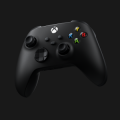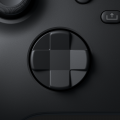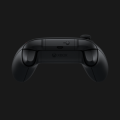New Xbox Series X details show the console's specs, graphical capabilities, and the new controller
The next generation of gaming is rapidly approaching, and thanks to some new information supplied by Xbox themselves, everyone can now get a glimpse of what the future will hold. The full technical specifications of the Xbox Series X console have been unveiled, along with screenshots of tech demos of Minecraft and Gears of War 5 both utilizing the new graphical power of the console, details about backwards compatibility, and more.
Kicking things off, here are the full specs of the system:
CPU 8x Cores @ 3.8 GHz (3.6 GHz w/ SMT) Custom Zen 2 CPU
GPU 12 TFLOPS, 52 CUs @ 1.825 GHz Custom RDNA 2 GPU
Die Size 360.45 mm2
Process 7nm Enhanced
Memory 16 GB GDDR6 w/ 320b bus
Memory Bandwidth 10GB @ 560 GB/s, 6GB @ 336 GB/s
Internal Storage 1 TB Custom NVME SSD
I/O Throughput 2.4 GB/s (Raw), 4.8 GB/s (Compressed, with custom hardware decompression block)
Expandable Storage 1 TB Expansion Card (matches internal storage exactly)
External Storage USB 3.2 External HDD Support
Optical Drive 4K UHD Blu-Ray Drive
Performance Target 4K @ 60 FPS, Up to 120 FPS
The beefy Series X plans to aim for games with 4K graphics, and a framerate of 60fps, thanks to its 8 core AMD Zen 2 processor, coupled with a custom RDNA 2 GPU. Digital Foundry got to see the system in action early, even tearing down the console to its components, and going in-depth with some of the new features of the Series X. The nearly 30-minute video can be seen here.
We also have confirmation that Gears of War 5, which originally launched on the Xbox One, will be an "optimized" launch title for the Series X, with the next-gen version free to those who already own the game on the Xbox One. Where the game used to run at 30fps on console, it now can reach 60fps in cutscenes, after a few weeks of slight work on the port. Minecraft also was shown running on the system, with hardware-accelerated Raytracing giving the game a brand new look, with high-quality lighting effects.
To close out the segment on the power of Xbox Series X, The Coalition’s Technical Director, Mike Rayner, came up to show us how his team is planning to optimize Gears 5 for Xbox Series X. The team showcased a technical demo of Gears 5, powered by Unreal Engine, for Xbox Series X using the full PC Ultra Spec settings, which included higher resolution textures and higher resolution volumetric fog, as well as a 50% higher particle count than the PC Ultra Specs allowed. They also showed off the opening cutscene, which now runs at 60 FPS in 4K (it was 30 FPS on Xbox One X), meaning the transition from real-time cutscenes to gameplay is incredibly smooth.
There’s also the new Quick Resume technology that we outlined in our last blog post. With current gen consoles, you can resume the last game you played. However, since most players play (on average) three to four games a month, the team wanted to give them the option to switch between them easily and quickly. With Quick Resume, you can resume multiple games with the press of a button, instantly jumping back into the action, right where you left off, for multiple titles at the same time.
Since game states will be stored directly in the system’s SSD, they’ll even persist after you turn off the console, unplug it entirely, or even take a system update. One of the testers on the team unplugged his console for a week, then took an update, and was still able to continue right where he left off without so much as a loading screen.
While it took a few years for the Xbox One to become backwards compatible with the Xbox 360, that won't be the case with the next-generation. The Series X plans to have games from the original XBox, to the 360, and the One all available to play, and even perhaps improved on the new hardware. Cross-generational multiplayer will also be a feature, as well as being able to bring save files of your backwards compatible games forward to the Series X.
Lastly, we got to see some new images that show off the controller and its textured bumpers, new d-pad, and the share button. The d-pad is a slight hybrid between the 360's and the One's, with a "dish" style that attempts to take the best from both controllers. The controller will also have low wireless latency, "shaving off precious miliseconds at every step of gameplay". Previously, a handful of limited controllers for the Xbox One offered textured triggers, and so will this gamepad, hopefully making the triggers easier to grip, with its raised bumps along the top.Players will see the benefits of the improved hardware of Xbox Series X for backwards compatible games, including improved boot and load times, more stable frame rates, higher resolutions and improved image quality. The Compatibility team is also continuing to create entirely new techniques and innovation that we can use to further enhance the existing catalog of games when running on Xbox Series X.
The Xbox team is so committed to the concept of compatibility and cross generation play, that not only do your games move forward with you, but so do your Xbox One accessories, your game saves, and progression. In fact, your entire gaming legacy moves forward with you to the next generation.
With each generation of controllers, from Xbox to Xbox 360 to Xbox One to Xbox One S, the Xbox hardware team has led and innovated input for gaming. They’ve set new bars with Elite and Adaptive Controllers in performance, features, quality, and accessibility. When considering the next generation of gaming, they wanted to build on this legacy. At its core, Xbox Series X is all about speed, compatibility across generations, and the power to create deeper experiences. The team wanted to develop a controller that helps fully realize these promises, keeping in mind that even improvements that may seem small initially can make a big impact. At the same time, given the love fans have for the current controller, they wanted to ensure they didn’t change things just for the sake of change; building on the Xbox One controller in smart, evolutionary ways while ensuring the muscle memory players have built up over the years remains intact.
With those principles in mind, the Xbox design team developed a next-generation controller to deliver what fans wanted most: improved ergonomics for a wider range of people, better cross-device connectivity, easier sharing, and reduced latency. We had a chance to sit down recently with Ryan Whitaker, Senior Designer at Xbox, to talk about the team’s philosophy in designing the new Xbox Wireless Controller that will be included with Xbox Series X this holiday.
Xbox Wire: Did you make design choices with the new Wireless Controller to be more inclusive of all players?
Ryan Whitaker: Yes. Being more inclusive is part of the design process from the very beginning. That’s true for everything we make at Xbox. Whether we’re redesigning our standard controller or inventing a completely new one, like the Adaptive Controller, we ask ourselves and gamers, “How can we make gaming a better experience for everyone?” By listening to gamers and observing how people of all backgrounds and abilities play, we continue to learn more and find areas we can improve.
Xbox Wire: What sort of specific design changes did you make to reach that goal?
Ryan Whitaker: One key area we’re improving is fitting a wider range of hand sizes, especially smaller hands. By accommodating hands similar to those of an average 8-year-old, we found we could improve accessibility and comfort for hundreds of millions more people without negatively affecting the experience for those with larger hands. We did that by rounding the bumpers, slightly reducing and rounding parts around the triggers, and carefully sculpting the grips.
Xbox Wire: Why did you decide to change the design of the D-pad?
Ryan Whitaker: The new D-pad is about boosting performance and accessibility for all the ways people play. (And it’s one of my favorite parts of the new design.) When looking at the wide range of game genres and personal playstyles today, the D-pad is used in a lot of different ways. That’s why our Elite controllers have swappable D-pads. For some games, having crisp cardinal directions (up, down, left, right) with well-defined edges is what gamers need, and the cross is great for that. Some gamers need to hit accurate diagonals or perform sweep actions, which is where the facetted dish is designed to excel. And, of course, based on personal playstyles, some people just prefer one over the other.
Building on what we learned from Elite and watching how people use the D-pad, we designed a hybrid to deliver the best of both. It feels great. The slightly deeper dish gives your thumb a nice little “home” to sit in. The angles are finely tuned to give you a good amount of leverage with minimal movement. Gamers will notice a performance boost right out of the box.
Xbox Wire: How important was compatibility and connectivity in your design?
Ryan Whitaker: Both are critical to gaming experiences right now. Gamers want to play games on all of their devices. That includes the ability to play classic games and the latest AAA titles on a phone through xCloud. The new controller needs to work equally well on Xbox One and pairing and moving between all these devices needs to be easy.
This level of compatibility and connectivity has become the norm for devices and accessories. Increasingly, the controller will be the common touch point to your Xbox games across devices. It’s the one consistent piece of hardware in all these interconnected experiences. So we designed it to work that way.
Xbox Wire: What steps did you take to ensure compatibility and improved connectivity?
Ryan Whitaker: Designing for compatibility and connectivity has a wide range of implications. Some improvements are completely invisible and work in the background. Others help define the shape of the controller.
First, we’re supporting cross-compatibility between Xbox Series X and Xbox One consoles and controllers. They all work together with the same great Xbox Wireless Radio. Gamers can also play on more devices including PC, Android, and iOS. We’re implementing Bluetooth Low Energy (BTLE) so that pairing to these devices is much easier. The new controller also remembers multiple devices so switching between them is more seamless. And a USB-C port allows gamers to play and charge with a modern cable that’s more readily available.
Another area in which gamers are always looking for connectivity improvements is reducing latency. We’re introducing a system-wide set of improvements we call Dynamic Latency Input (DLI), which includes specific technology in the console and the HDMI connection to your TV. And it all starts with the controller. Essentially, information is sent more frequently from the controller and matched with exact frames of your game on-screen. The result: we shave off precious milliseconds at every step of gameplay, and actions are even more instantaneous.
All of these improvements work in the background and are fairly invisible. We also wanted to maintain back-compatibility with accessories people already have in their collection. Since those are physical connections, that defines the shape of the lower half of the controller as well as the location of the audio and accessory ports. Ultimately, that means you can plug in your Chatpad or headset on day one, and it still just works.
Xbox Wire: Why did you decide to add a Share button?
Ryan Whitaker: Gaming is an important way people connect with each other. It’s often how friends hang out and stay in touch. Capturing and sharing epic or meme-worthy moments are part of that experience and should be as quick and unobtrusive as possible. Adding a Share button is the best way to make capturing and sharing instantaneous. It’s easy to just grab a screenshot or record a video without needing on-screen menus. Then you can easily access and share content with your favorite social platforms or directly with friends.
Xbox Wire: The controller has some new textures and finishes. Can you tell us a bit more about this?
Ryan Whitaker: We added a tactile dot pattern on the triggers and bumpers, which provides grip to improve feel and performance during gameplay. That’s something we’ve had on special edition controllers and fans love it. Now it’s the new standard. A similar, yet more subtle pattern is on the grips. The D-pad, bumpers, and triggers now have a matte finish to maintain a smooth consistent feel, whether your hands are wet or dry.
Thanks to Ryan for taking the time to speak with us about the new Xbox Wireless Controller. For more on Xbox Series X, check out our features taking a closer look at the tech powering the Xbox Series X, our primer on latency and what the team is doing to improve it, and our glossary of next-gen terms.
The Xbox Series X is still slated for a Holiday 2020 launch.












